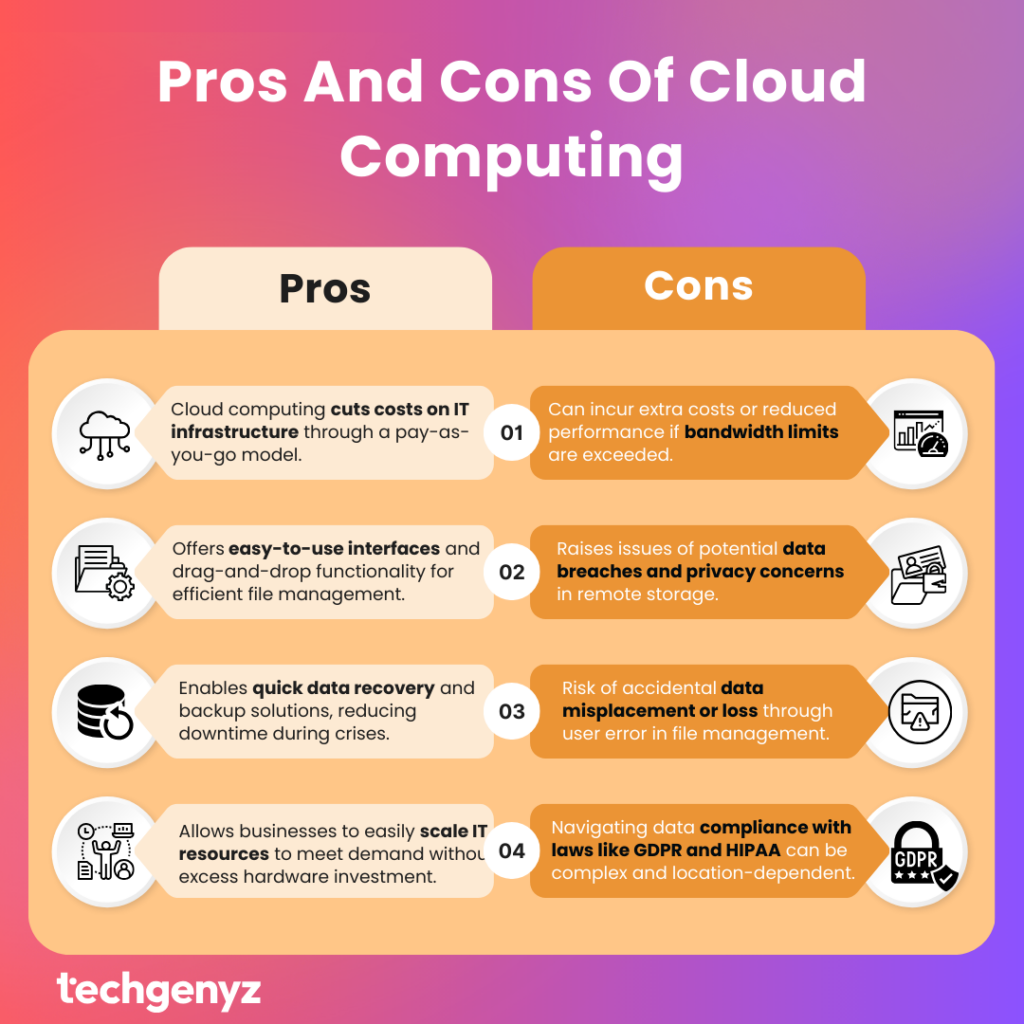Cloud computing is software that allows you to save your enormous data online and use it at any time from anywhere, on any device. It has been used by many organizations to manage their huge amounts of data.
It is very easy to access and gives you an option to share your data with others. Some companies hire Website Development Companies to manage their official data, but most companies use cloud computing to do that. Let’s explore the pros and cons of cloud computing.
Cloud computing has revolutionized how businesses and individuals store, access, and manage data. Its growing popularity stems from its ability to simplify IT operations and provide scalable resources on demand. However, as with any technology, it comes with its set of challenges. Let’s delve deeper into the pros and cons of cloud computing, expanding the list to highlight 8 major advantages and disadvantages suitable for the evolving digital landscape.

Table of Contents
Pros
Save money and resources.
Instead of focusing on the wide lifting of racking, stacking, and powering servers, cloud computing allows you to focus on your own users and projects. You can buy cloud computing support once as per your requirements, and later, if any upgrade is required, you can easily upgrade your services plan. The software doesn’t even need maintenance, and this is how it saves your money and resources.
Usability
Cloud computing offers enhanced usability with its unique features and functionalities. It provides several desktop features for Mac and Windows computers.
Users can easily drag and drop their files or folders between the cloud storage and their local storage through the drag and drop option.
Good for Recovery
Cloud computing can help you back up your data, and in case of an emergency, you can easily get your data back. The backed-up files are securely stored online and can be accessed at any point in time from anywhere. It works as a rescue in case of sudden software crashes and hardware damage.
Scalability
One of the most significant benefits of cloud computing is its scalability. Companies can scale their IT infrastructure up or down with ease, depending on current demand. This means they can adapt to peak times without investing in physical infrastructure that might remain underutilized during slower periods.
Cons
Bandwidth
Cloud Computing has a limited bandwidth allowance that refers to the rate at which the data is transmitted over a network. The performance of the connection depends on the capacity. In more simple words, the higher capacity leads your connection to better performance. The drawback here is that if you cross the given limit of the bandwidth, it could charge you additional charges.
Data Security
Cloud computing is very secure, but there are some concerns about the safety and privacy of remotely stored data. The stored data is also shared with third parties to make your experience more convenient, and that can be a matter of concern. You might not like sharing your data with third parties you don’t know. Website Development Services can help you with your data security.
Drag and Drop
Although drag-and-drop is an interesting feature, it might interrupt your seamless experience. If you are not careful enough while using the feature, you could permanently shift your document from its original folder to the cloud storage location. So, if you wish to keep the folder at both locations, do not use the drag-and-drop feature; instead, you can use copy-and-paste.
Compliance and Legal Issues
Storing data in the cloud can complicate compliance with data protection regulations, such as GDPR or HIPAA. Businesses must ensure their cloud solutions comply with relevant laws and standards, which can vary depending on the location of the cloud servers and the nature of the stored data.
Conclusion
As cloud computing continues to evolve, it’s essential for businesses and individuals to weigh its benefits against potential drawbacks. By understanding these pros and cons, users can make informed decisions about implementing cloud solutions, ensuring they harness the power of cloud computing effectively while mitigating associated risks.




